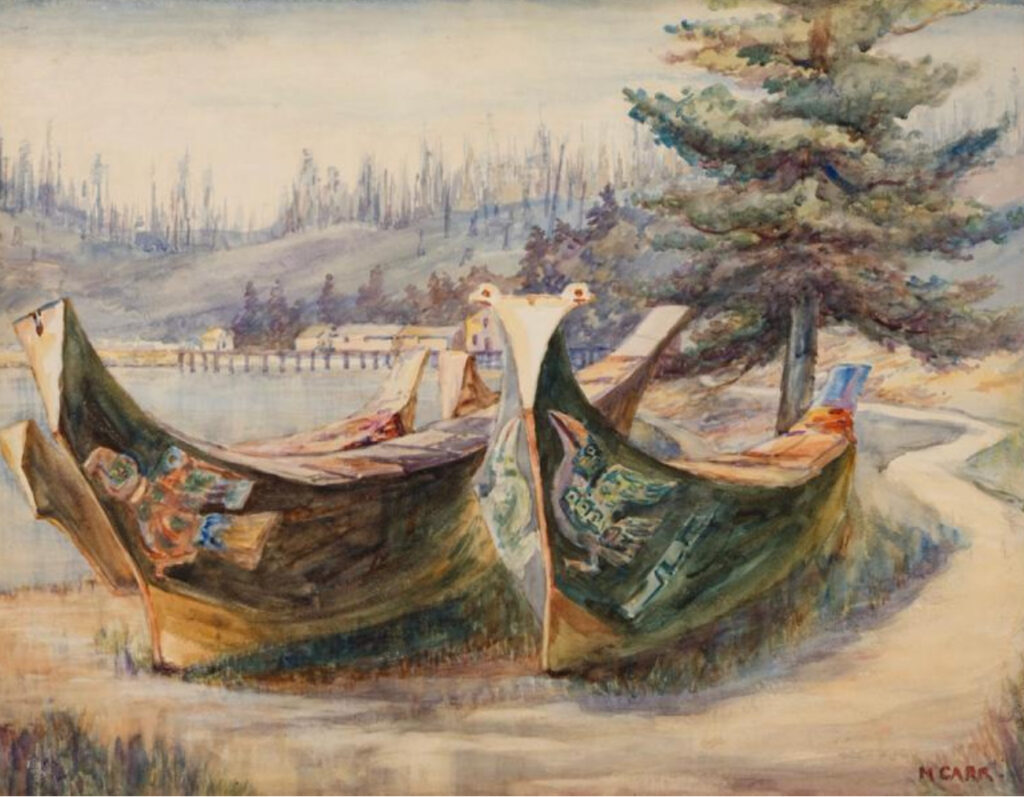The Audain Art Museum’s recent acquisition of an early Emily Carr watercolor marks a critical moment for both the museum and the broader landscape of Canadian art. Emily Carr is an iconic figure whose career represents a profound exploration of the Canadian wilderness and Indigenous cultures of British Columbia. While her later oil paintings are celebrated for their bold, rhythmic brushstrokes and distinctive color palettes, her earlier works, especially in watercolor, offer a rare and intimate look into her artistic evolution.
The early watercolor acquired by the Audain Art Museum is significant not only because it is a rare find but also because it allows for a more nuanced understanding of Carr’s development as an artist. Watercolors have often been overlooked in the discussion of her work, with more attention given to her oil paintings and her connection to the Group of Seven. However, this acquisition opens up new possibilities for understanding the foundational techniques and ideas that would later inform her groundbreaking contributions to Canadian art.
Emily Carr’s Artistic Evolution
Emily Carr (1871–1945) is best known for her vibrant depictions of the British Columbia landscape, especially its towering trees and dense forests, as well as her sensitive renderings of Indigenous totem poles and villages. Yet, Carr’s career did not begin with the sweeping oil paintings for which she is most famous. She initially trained in traditional European academic styles and experimented with various media, including watercolor.
Carr’s early years as an artist were shaped by her education in San Francisco and later in London and Paris. She absorbed influences from the British landscape tradition, which prized delicate treatment of light and color, as well as from post-Impressionist movements that were taking root in Paris at the time. The result was an artist deeply committed to observation but also willing to push boundaries in terms of technique and subject matter.
In her early works, especially her watercolors, Carr often focused on more intimate, quieter scenes. These watercolors provide a glimpse into her relationship with nature before her work evolved into the dynamic, abstracted forms for which she is better known. The Audain Art Museum’s newly acquired watercolor, from the late 19th century, offers an early example of Carr’s engagement with landscape, executed in a way that shows her deepening relationship with British Columbia’s rugged wilderness.
The Significance of Watercolor in Carr’s Oeuvre
Watercolor, as a medium, is often sidelined in discussions of Carr’s work. Her later oils, with their thick textures and bold compositions, tend to dominate exhibitions and scholarship. However, watercolor played a crucial role in her early development. It was a medium that allowed Carr to work quickly, capturing fleeting moments and subtle shifts in light and atmosphere. While oil painting would later enable her to create more dramatic and monumental images, watercolor provided a space for experimentation and exploration.
The watercolor acquired by the Audain Art Museum likely dates from a period when Carr was just beginning to assert her independence as an artist. After her studies in Europe, Carr returned to British Columbia and embarked on a series of sketching trips, during which she began to develop her own style. Watercolor would have been an ideal medium for these excursions—it is portable and relatively easy to use in the field. The immediacy of watercolor also allowed Carr to respond quickly to the changing landscape, capturing the ephemeral qualities of light and weather that are so central to her work.
In many ways, Carr’s watercolors act as visual diaries, recording her encounters with the landscape and Indigenous cultures that would later dominate her mature work. They also reveal her growing confidence as an artist. While her early watercolors are often more representational than her later oils, they still demonstrate a keen sense of composition and an emerging interest in the interplay between form and space.
The Audain Art Museum’s Role in Preserving Canadian Art
The acquisition of this early Carr watercolor is a significant milestone for the Audain Art Museum, further cementing its role as a key institution for the preservation and celebration of Canadian art. Located in Whistler, British Columbia, the Audain Art Museum is uniquely positioned to showcase the work of artists who, like Carr, were deeply influenced by the natural beauty and cultural history of the region.
The museum’s collection already includes several works by Carr, along with pieces from other prominent Canadian artists such as E.J. Hughes, Lawren Harris, and Bill Reid. By acquiring this early watercolor, the museum is not only expanding its collection but also providing visitors with a more comprehensive view of Carr’s artistic trajectory. The addition of this work allows for a more nuanced understanding of how Carr’s style evolved over time, from her early, more representational watercolors to her later, more abstract oils.
Moreover, the Audain Art Museum’s focus on British Columbian art makes it an ideal home for this particular watercolor. The museum’s mission is to highlight the cultural and artistic contributions of the region, and Carr is undoubtedly one of the most important figures in that story. Her work is inseparable from the landscapes and Indigenous cultures of British Columbia, and the museum’s acquisition of this early piece deepens its connection to that legacy.
Thematic Explorations in the Early Watercolor
Although the specific subject matter of the newly acquired watercolor has not been widely discussed, it is likely that the work reflects Carr’s early fascination with British Columbia’s landscapes. During her formative years, Carr was known for painting forests, rivers, and coastal scenes, often focusing on the relationship between the land and the sky. These early works are characterized by a gentle, almost reverent approach to nature, in contrast to the more dramatic, spiritual interpretations that define her later oil paintings.
What makes Carr’s early watercolors particularly interesting is the way they combine European academic traditions with a uniquely Canadian sensibility. The composition of these works often adheres to the conventions of European landscape painting—careful attention to perspective, a balanced distribution of forms across the picture plane—but there is also something distinctly North American in Carr’s treatment of the wilderness. Her watercolors convey a sense of vastness and isolation, qualities that would come to define Canadian landscape painting in the 20th century.
In this early watercolor, we might also see the beginnings of Carr’s interest in Indigenous cultures, an interest that would later become a central theme in her work. While her early works do not yet display the totem poles and village scenes that would later dominate her oeuvre, they do reflect a growing awareness of the cultural and spiritual significance of the land. Carr’s watercolors often depict landscapes that are not just beautiful but imbued with a sense of history and meaning.
Reconsidering Carr’s Legacy Through Early Works
The acquisition of this early watercolor offers an opportunity to reconsider Emily Carr’s legacy. While she is often celebrated as a mature artist who helped shape Canadian modernism, her early works are sometimes overlooked in discussions of her career. Yet these early pieces are crucial to understanding how Carr developed her unique voice. They show an artist in the process of finding her way, experimenting with different media, techniques, and subjects.
In many ways, Carr’s early watercolors reflect the tensions and contradictions that would come to define her later work. On the one hand, they are rooted in European traditions, reflecting her formal training in San Francisco, London, and Paris. On the other hand, they are deeply personal, reflecting Carr’s own encounters with the landscape and cultures of British Columbia. These early works offer a glimpse into the process by which Carr began to merge these two influences, creating a style that was at once deeply informed by European modernism and uniquely Canadian.
The early watercolor acquired by the Audain Art Museum is not just a historical artifact; it is a work of art that continues to speak to contemporary audiences. In an era when issues of land, environment, and Indigenous rights are at the forefront of public consciousness, Carr’s work feels more relevant than ever. Her early watercolors, with their sensitive treatment of the natural world, remind us of the importance of seeing the landscape not just as a resource to be exploited but as a living entity with its own history and meaning.
Impression
The Audain Art Museum’s acquisition of this early Emily Carr watercolor is a significant moment for the institution and for Canadian art as a whole. It represents a rare opportunity to explore an often-overlooked aspect of Carr’s career, one that is essential to understanding her development as an artist. While Carr is best known for her later oil paintings, her early watercolors offer a glimpse into the foundational ideas and techniques that would later shape her mature work.
By adding this watercolor to its collection, the Audain Art Museum is not only expanding its representation of Carr’s work but also contributing to a broader understanding of Canadian art. The museum’s focus on British Columbian art makes it an ideal home for this piece, which reflects both the region’s natural beauty and its cultural history. As visitors encounter this early work, they are invited to see Carr in a new light—not just as a master of modernism but as an artist who was constantly evolving, experimenting, and responding to the world around her.
The acquisition also raises important questions about the role of watercolors in Carr’s oeuvre and in Canadian art more broadly. While oil painting has traditionally been seen as the more prestigious medium, watercolors offer a different kind of intimacy and immediacy. Carr’s early watercolors, in particular, show an artist who was deeply attuned to the subtleties of light, color, and form, even as she grappled with the larger themes of identity, culture, and nature that would come to define her career.
In the end, this early Emily Carr watercolor is more than just a new addition to the Audain Art Museum’s collection—it is a key to unlocking a deeper understanding of one of Canada’s most important artists. Through this work, we can see not only where Carr began but also where she was headed, as she continued to push the boundaries of what it meant to be a Canadian artist in the 20th century
No comments yet.








